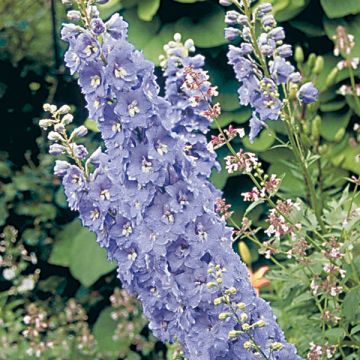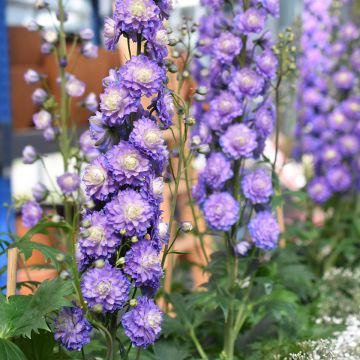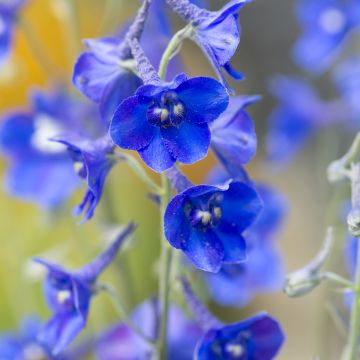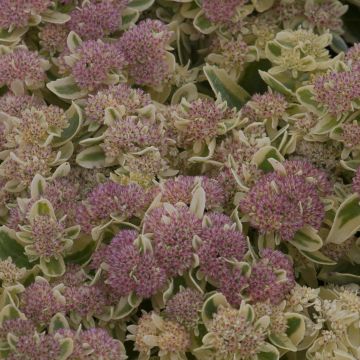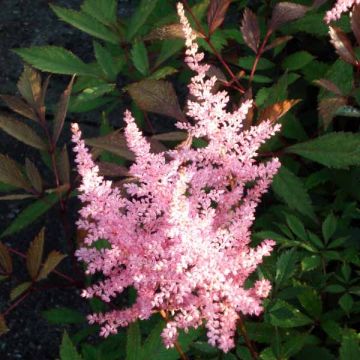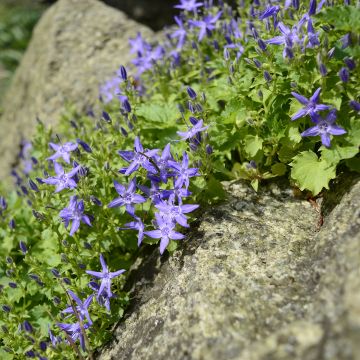

Delphinium belladonna Bellamosum - Larkspur


Delphinium belladonna Bellamosum - Larkspur
Delphinium belladonna Bellamosum - Larkspur
Delphinium x belladona Bellamosum
Belladonna Larkspur, Perennial Larkspur
This item cannot be shipped to the selected country
Delivery charge from €5.90
Delivery charge from €5.90
More information
Schedule delivery date,
and select date in basket
This plant carries a 12 months recovery warranty
More information
We guarantee the quality of our plants for a full growing cycle, and will replace at our expense any plant that fails to recover under normal climatic and planting conditions.
From €5.90 for pickup delivery and €6.90 for home delivery
Express home delivery from €8.90.
From €5.90 for pickup delivery and €6.90 for home delivery
Express home delivery from €8.90.
Does this plant fit my garden?
Set up your Plantfit profile →
Description
The Delphinium x belladonna 'Bellamosum' is a variety of larkspur that combines many qualities. With a beautiful stature for a belladonna, it offers fabulous gentian blue flowering, highlighted by a small almost black eye in the heart of each flower. Its flower stems appear in early summer, then again in September if care is taken to remove faded flowers. It also stands out for its increased resistance to mildew and the appetite of slugs which too often disfigure or destroy other larkspur plants. Being perennial and cold-resistant, it will flower again each year in romantic or country-style flowerbeds, with its head in the sun and its feet in fertile and moist soil.
The Delphinium belladonna 'Bellamosum' is a plant in the family Ranunculaceae belonging to a group of perennial varieties obtained through the cross-breeding of Delphinium elatum and Delphinium grandiflorum. 'Bellamosum' will reach a height of approximately 1.2m (4ft) when in bloom, under optimal growing conditions. In ordinary garden soil without fertilizer or water, it will reach a height of 70-80cm (28-32in), without the need for staking when sheltered from the wind. Floral stems emerge from a tuft of large palmate and finely divided leaves, first in June-July, then again in September-October. This variety produces branched and slightly loose spikes, 30cm (12in) long, adorned with small flowers measuring 2 to 5cm (1 to 2in) in diameter, usually single, graceful, and light, with a puckered spur that appears frosty. They are an extraordinary blue, bright, striking, almost electric, enhanced by an iridescent and pearly texture, and an almost black centre. The plant develops from a woody rootstock that plunges vertically into the soil, which must be flexible and deep enough to accommodate it.
Delphiniums are highly floriferous perennial plants that always stand out in a garden. Belladonna hybrid delphiniums offer a unique way to appreciate these plants. They bring the joy of consistent and faithful blooming, reliably appearing in the expected locations for several years, eliminating the need for regular use of slug pellets. Their characteristic silhouette always adds volume, height, and a lot of charm to perennial plant beds, with an added brightness. They are also good companions for moss or gallica roses, with which they form charming and romantic compositions. You can also create another beautiful combination with soft orange daylilies, chamomiles, and the baby's breath Rosenschleier. Their long-lasting flowers blend well with peonies, roses, white Arum lilies, scabious, foxgloves...
Note: From March to September, the stems of our delphiniums are pruned short to promote better branching of the stump and achieve optimal rooting. This pruning also prevents the stems from breaking during transportation.
Report an error about the product description
Delphinium belladonna Bellamosum - Larkspur in pictures


Flowering
Foliage
Plant habit
Safety measures
Botanical data
Delphinium
x belladona
Bellamosum
Ranunculaceae
Belladonna Larkspur, Perennial Larkspur
Cultivar or hybrid
ingestion
Cette plante est toxique si elle est ingérée volontairement ou involontairement.
Ne la plantez pas là où de jeunes enfants peuvent évoluer, et lavez-vous les mains après l'avoir manipulée.
Pensez à conserver l'étiquette de la plante, à la photographier ou à noter son nom, afin de faciliter le travail des professionnels de santé.
Davantage d'informations sur https://plantes-risque.info
Other Delphinium - Larkspur
Planting and care
Delphinium belladonna Bellamosum prefers to be planted in full sun and sheltered from strong winds. Plant it in a rich, moist, but well-drained soil. It dislikes heavy and wet soils, as well as poor and dry soils, but tolerates a small amount of limestone. Plant it in autumn or spring, after the last frost. While very easy to grow, be sure to provide regular watering to maintain vegetation and apply liquid fertilizer every two to three weeks during growth. Avoid very windy exposures. Stake when the plant reaches 30cm (12in) in height as the stems are fragile and easily break under the weight of the flowers. Remove faded flowers by cutting the spikes at the level of the small lateral flowering shoots. Cut the entire plant back to ground level in autumn. Leave a minimum of two or three shoots on young plants and five to seven on well-established delphiniums. Remove flower stems as soon as they no longer have flowers for a second flowering in late summer. Slugs are to be monitored (use slug repellents from February). This belladonna species is more resistant to diseases than other Delphinium species and seems less appetizing to slugs and snails.
Planting period
Intended location
Care
-
, onOrder confirmed
Reply from on Promesse de fleurs
Summer flowering perennials
Haven't found what you were looking for?
Hardiness is the lowest winter temperature a plant can endure without suffering serious damage or even dying. However, hardiness is affected by location (a sheltered area, such as a patio), protection (winter cover) and soil type (hardiness is improved by well-drained soil).

Photo Sharing Terms & Conditions
In order to encourage gardeners to interact and share their experiences, Promesse de fleurs offers various media enabling content to be uploaded onto its Site - in particular via the ‘Photo sharing’ module.
The User agrees to refrain from:
- Posting any content that is illegal, prejudicial, insulting, racist, inciteful to hatred, revisionist, contrary to public decency, that infringes on privacy or on the privacy rights of third parties, in particular the publicity rights of persons and goods, intellectual property rights, or the right to privacy.
- Submitting content on behalf of a third party;
- Impersonate the identity of a third party and/or publish any personal information about a third party;
In general, the User undertakes to refrain from any unethical behaviour.
All Content (in particular text, comments, files, images, photos, videos, creative works, etc.), which may be subject to property or intellectual property rights, image or other private rights, shall remain the property of the User, subject to the limited rights granted by the terms of the licence granted by Promesse de fleurs as stated below. Users are at liberty to publish or not to publish such Content on the Site, notably via the ‘Photo Sharing’ facility, and accept that this Content shall be made public and freely accessible, notably on the Internet.
Users further acknowledge, undertake to have ,and guarantee that they hold all necessary rights and permissions to publish such material on the Site, in particular with regard to the legislation in force pertaining to any privacy, property, intellectual property, image, or contractual rights, or rights of any other nature. By publishing such Content on the Site, Users acknowledge accepting full liability as publishers of the Content within the meaning of the law, and grant Promesse de fleurs, free of charge, an inclusive, worldwide licence for the said Content for the entire duration of its publication, including all reproduction, representation, up/downloading, displaying, performing, transmission, and storage rights.
Users also grant permission for their name to be linked to the Content and accept that this link may not always be made available.
By engaging in posting material, Users consent to their Content becoming automatically accessible on the Internet, in particular on other sites and/or blogs and/or web pages of the Promesse de fleurs site, including in particular social pages and the Promesse de fleurs catalogue.
Users may secure the removal of entrusted content free of charge by issuing a simple request via our contact form.
The flowering period indicated on our website applies to countries and regions located in USDA zone 8 (France, the United Kingdom, Ireland, the Netherlands, etc.)
It will vary according to where you live:
- In zones 9 to 10 (Italy, Spain, Greece, etc.), flowering will occur about 2 to 4 weeks earlier.
- In zones 6 to 7 (Germany, Poland, Slovenia, and lower mountainous regions), flowering will be delayed by 2 to 3 weeks.
- In zone 5 (Central Europe, Scandinavia), blooming will be delayed by 3 to 5 weeks.
In temperate climates, pruning of spring-flowering shrubs (forsythia, spireas, etc.) should be done just after flowering.
Pruning of summer-flowering shrubs (Indian Lilac, Perovskia, etc.) can be done in winter or spring.
In cold regions as well as with frost-sensitive plants, avoid pruning too early when severe frosts may still occur.
The planting period indicated on our website applies to countries and regions located in USDA zone 8 (France, United Kingdom, Ireland, Netherlands).
It will vary according to where you live:
- In Mediterranean zones (Marseille, Madrid, Milan, etc.), autumn and winter are the best planting periods.
- In continental zones (Strasbourg, Munich, Vienna, etc.), delay planting by 2 to 3 weeks in spring and bring it forward by 2 to 4 weeks in autumn.
- In mountainous regions (the Alps, Pyrenees, Carpathians, etc.), it is best to plant in late spring (May-June) or late summer (August-September).
The harvesting period indicated on our website applies to countries and regions in USDA zone 8 (France, England, Ireland, the Netherlands).
In colder areas (Scandinavia, Poland, Austria...) fruit and vegetable harvests are likely to be delayed by 3-4 weeks.
In warmer areas (Italy, Spain, Greece, etc.), harvesting will probably take place earlier, depending on weather conditions.
The sowing periods indicated on our website apply to countries and regions within USDA Zone 8 (France, UK, Ireland, Netherlands).
In colder areas (Scandinavia, Poland, Austria...), delay any outdoor sowing by 3-4 weeks, or sow under glass.
In warmer climes (Italy, Spain, Greece, etc.), bring outdoor sowing forward by a few weeks.


































